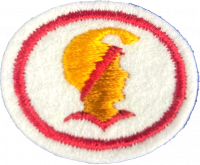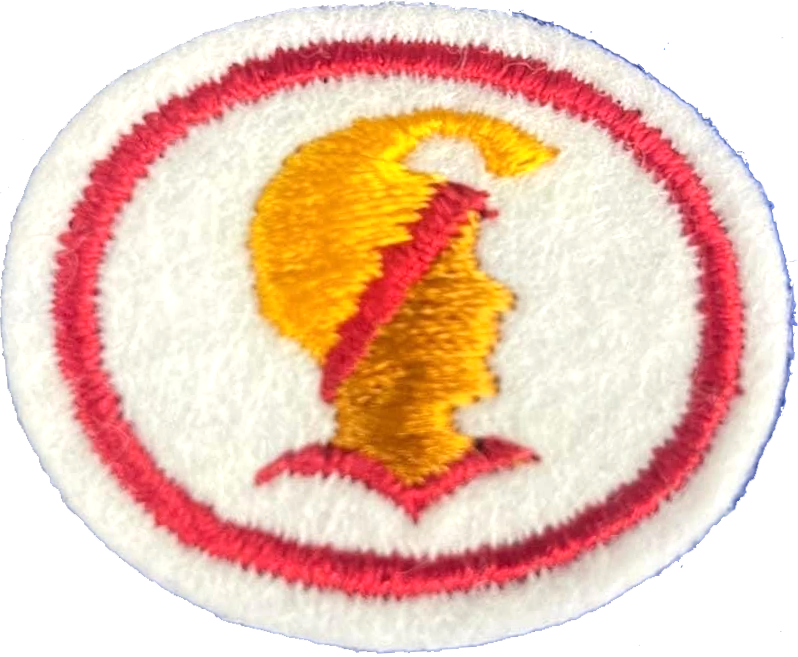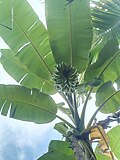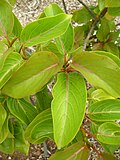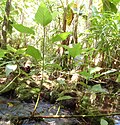Difference between revisions of "AY Honors/Hawaiian Lore/Answer Key"
(+ some more answers) |
|||
| Line 568: | Line 568: | ||
<big><u>'''LEGENDS'''</u></big> | <big><u>'''LEGENDS'''</u></big> | ||
| − | ''Maui and the Sun'' | + | <div class="mw-collapsible mw-collapsed" style="width:100%" data-expandtext="Expand Story" data-collapsetext="Collapse Story"> |
| + | ''<h2>Maui and the Sun</h2>'' | ||
| + | <div class="mw-collapsible-content"> | ||
| − | Maui lived | + | Maui lived with his mother, Hina, at Makalia on the west side of Maui, near the end of Mauna Kahalawai, the meeting place between heaven and earth. He lived there with his brothers. It was where the mountain thrust itself into the sea and one was able to see Haleakala on the east side of Maui as he looked across the water. Haeakala, House of the Sun, was believed to be the abode of the sun at night. |
Now, Maui and his brothers had never taken notice of the sun's travels across the sky for they were usually busy going about their own activities, fishing and swimming. Each morning saw them ready to go out in their canoe with their nets and lines, thinking only of the fish they would carch and of the fun they would have swimming. But their mother, Hina, was kept busy for she had to provide enough kapa for the family and kapa making was not really fun. She was having trouble getting her kapa dry before dark. | Now, Maui and his brothers had never taken notice of the sun's travels across the sky for they were usually busy going about their own activities, fishing and swimming. Each morning saw them ready to go out in their canoe with their nets and lines, thinking only of the fish they would carch and of the fun they would have swimming. But their mother, Hina, was kept busy for she had to provide enough kapa for the family and kapa making was not really fun. She was having trouble getting her kapa dry before dark. | ||
| Line 580: | Line 582: | ||
The wauke strips were narrow, so to make a wide piece, on had to joine several strips together by beating along the edges. The final beating was done with a carved beater to decorate the kapa before being painted or stamped with native vegetable or mineral dyes. This work took all day or longer, and then the kapa was laid out to dry. So the sun was very necessary. So often it set before the kapa was dry enough to put away. | The wauke strips were narrow, so to make a wide piece, on had to joine several strips together by beating along the edges. The final beating was done with a carved beater to decorate the kapa before being painted or stamped with native vegetable or mineral dyes. This work took all day or longer, and then the kapa was laid out to dry. So the sun was very necessary. So often it set before the kapa was dry enough to put away. | ||
| − | + | </div> | |
| + | </div> | ||
| + | -------------------------------------------------------- | ||
| + | <div class="mw-collapsible mw-collapsed" style="width:100%" data-expandtext="Expand Story" data-collapsetext="Collapse Story"> | ||
| + | ''<h2>How the Coconut First Grew in Hawaii</h2>'' | ||
| + | <div class="mw-collapsible-content"> | ||
| + | The most popular belief of how the first coconut came to grow in Hawaii is that it was brought here. Another belief is that it floated for days, weeks, and even months, and finally cast on the shores where it grew on the beach. Well, here is a story about how it was brought here. | ||
| − | + | ʻĀpua and Aukelenui were brothers who came here from Kahiki (Tahiti). They first went to Lanai after having visited the other islands. They could not find any edible plants or plants bearing edible fruits so became very hungry. So they returned to Kahiki. On arriving at Kahiki, they found that there were high seas so could not land. Before they had sailed for home, they filled their canoe with coral to pretend that the canoe was full. | |
| − | + | While they waited outside the landing place, a native of Kahiki named Kaulaku spotted ʻĀpua and his "loaded" canoe. Kaulaku and his people believed that ʻĀpua's canoe was loaded with food and wanted to sell or maybe buy more. So they showed them a banana. When ʻĀpua saw it, he called out to his men to show them a red coral which resembled a ripe red banana. He told Kaulaku that it was a ripe banana and that in Hawaii there were many bananas. So the people of Kahiki threw the bananas--fruit, tree trunks, and suckers--into the sea. ʻĀpua's men quickly gathered them into their canoe. | |
| − | + | Next, the people of Kahiki showed them some taro and ʻĀpua's men showed them a rock resembling taro too. So Kaulaku's people threw the taro into the sea. ʻĀpua's men retrieved the taro and the plants and stored them in the canoe. And so it went on with all the food plants. | |
| − | + | Finally, the people of Kahiki brought to the beach a large tree which resembled a halapepe. Quickly, ʻĀpua's men formed a tall tree which resembnled what we call a coconut tree. He told the people of Kahiki that it was a tree which grew in Hawaii and that it had bore fruit. Kaulaku and his people threw the halapepe tree into the sea. This ʻĀpua and his men gatherd and placed in the canoe. Then they returned to Hawaii. THey were sure they had enough plants to plan and thus furnish them with food they could not find in Hawaii. | |
| − | + | If you to to Puna, Hawaii, you will find a place there named ʻĀpua and you'd also find Kalapana and Kahualea, the two places where ʻĀpua and his men planted the first coconut tree. It was from here that coconuts were distributed throughout the Hawaiian islands. | |
| − | + | ANd over on Lanai, there is the place called Kaneapua, the place ʻĀpua and his men had first visited and felt the pangs of hunger due to the lack of food plants. | |
| + | </div> | ||
| + | </div> | ||
| − | |||
| − | |||
| − | |||
| − | |||
| − | |||
| − | |||
| − | |||
| − | |||
| − | |||
| − | |||
| − | |||
| − | |||
| − | |||
| − | |||
| − | |||
| − | |||
| − | |||
| − | |||
| − | |||
| − | |||
| − | |||
| − | |||
| − | |||
<!--T:88--> | <!--T:88--> | ||
Revision as of 03:11, 27 October 2024
1
Here is a list of the islands of Hawaii.
| 1. Hawaiʻi | 5. Molokaʻi |
| 2. Maui | 6. Lānaʻi |
| 3. Oʻahu | 7. Niʻihau |
| 4. Kauaʻi | 8. Kahoʻolawe |
2
3
The Hawaiian Islands are part of an archipelago in the North Pacific Ocean which extends for about 2000 miles from the big island Hawaii to Ocean Island on the northwest. (Latitude 18° 55' north, Longitude 154° 40' and 162° west.)
4
| Ocean Island | Maro Reef |
| Necker Island | Laysan Island |
| Midway Island | Lisianski Island |
| French Frigate Shoals | Pearl and Hermes Reef |
| Gardner Island | Molokaʻi |
| Dowsett Reef | Ford Island |
5
The Hawaiian islands are mostly volcanic with some coral. They really are tops of high mountains.
6
a. Māui was a demigod, a super man. Māui fished them from the ocean.
b. According to tradition, a large bird was seen wheeling and dipping over the ocean and suddently it dropped an egg, a very large egg, which burst into several fragments. These fragments formed the Hawaiian archipelago in the middle of the Pacific. The islands stretched from the northwest to the southeast, the eight islands the largest of them all.
c. The old Hawaiians believed that Kū, Kāne and Lono created the world and its people. Kāne took a large calabash cover and threw it into space to form the sky. He places his hand in the calabash and brought out a flaky white substance, threw it into the air and it became the clouds. He again placed his hand into the calabash and drew out a handful of seeds. These he threw into space and formed the stars, sun and moon. Then, once more he placed his hand in the calabash and folding his fingers formed valleys and lowlands. After the earth was created and springs of water had come into existence, Lono planted all things which made the earth beautiful. Kū was to create man.
7
Most of the year, the trade winds blow and the cool currents in the ocean around the islands keep the temperature lower than that of any other part of the world in the same latitude. The islands don't have bad storms like other parts of the world and the climate is warm and comfortable. The windward side usually is the rainy side, and the leeward side dry, except when the Kona winds blow from the south. There is snow during winter on the highest mountains; Mauna Kea and Mauna Loa on Hawaii, Haleakalā on Maui.
8
The soils are volcanic, sandy and hard clay. Volcanic soils are rich and plants grow easily. Sandy soils and cinders help to make hard soils soft for plants to grow well. Clay soil is good for taro.
9
9a
9b
For food:
For cord and house needs:
10
10a
10b
11
12
13
14
14a
14b
14c
14d
14e
14f
14g
14g
15
16
17
18
19
20
21
22
23
24
25
26
27
28
29
30
31
32
Oahu
Hawaii
| 1. Kilauea | 4. Honaunau |
| 2. Akaka Falls | 5. Parker's Ranch |
| 3. Waipio Valley | 6. Museum at Kona or Hulihee Palace |
Maui
| 1. Haleakalā | 4. Kauiki Hill |
| 2. Iao Valley | 5. Waianapanapa |
| 3. Lahaina Luna High | 6. Keanae Valley |
Kauai
| 1. Waimea Canyon | 7. Kuhio Park and Memorial |
| 2. Kokee | 8. Barking Sands |
| 3. Wailua River | 9. Kalalau Valley |
| 4. Fern Grotto | 10. Hanalei |
| 5. Menehune Ditch | 11. Haena Caves |
| 6. Wailua Falls |
LEGENDS
Maui and the Sun
Maui lived with his mother, Hina, at Makalia on the west side of Maui, near the end of Mauna Kahalawai, the meeting place between heaven and earth. He lived there with his brothers. It was where the mountain thrust itself into the sea and one was able to see Haleakala on the east side of Maui as he looked across the water. Haeakala, House of the Sun, was believed to be the abode of the sun at night.
Now, Maui and his brothers had never taken notice of the sun's travels across the sky for they were usually busy going about their own activities, fishing and swimming. Each morning saw them ready to go out in their canoe with their nets and lines, thinking only of the fish they would carch and of the fun they would have swimming. But their mother, Hina, was kept busy for she had to provide enough kapa for the family and kapa making was not really fun. She was having trouble getting her kapa dry before dark.
One morning, very early, Hina went to her mulberry (wauke) grove at Kahakuloa. There she stripped off the bark of the trees, rolled the strips and soaked them in calabashes filled with sea water to soak for a few days. After the soaking, she was going to stretch them over flat logs and scrape the bark off with a large shell. The strips would then be ready for beating.
Mother Hina had a house for kapa beating. Here she would sit before it and chant tot he goddess of kapa while she would bea tthe wauke strips with a kapa beater made of hardwood, usually kauila. Mother Hina always changted to the goddess of kapa because she and all of the Hawaiians believed that the goddess had changed herself into a wauke tree to help her people have clothing.
The wauke strips were narrow, so to make a wide piece, on had to joine several strips together by beating along the edges. The final beating was done with a carved beater to decorate the kapa before being painted or stamped with native vegetable or mineral dyes. This work took all day or longer, and then the kapa was laid out to dry. So the sun was very necessary. So often it set before the kapa was dry enough to put away.
How the Coconut First Grew in Hawaii
The most popular belief of how the first coconut came to grow in Hawaii is that it was brought here. Another belief is that it floated for days, weeks, and even months, and finally cast on the shores where it grew on the beach. Well, here is a story about how it was brought here.
ʻĀpua and Aukelenui were brothers who came here from Kahiki (Tahiti). They first went to Lanai after having visited the other islands. They could not find any edible plants or plants bearing edible fruits so became very hungry. So they returned to Kahiki. On arriving at Kahiki, they found that there were high seas so could not land. Before they had sailed for home, they filled their canoe with coral to pretend that the canoe was full.
While they waited outside the landing place, a native of Kahiki named Kaulaku spotted ʻĀpua and his "loaded" canoe. Kaulaku and his people believed that ʻĀpua's canoe was loaded with food and wanted to sell or maybe buy more. So they showed them a banana. When ʻĀpua saw it, he called out to his men to show them a red coral which resembled a ripe red banana. He told Kaulaku that it was a ripe banana and that in Hawaii there were many bananas. So the people of Kahiki threw the bananas--fruit, tree trunks, and suckers--into the sea. ʻĀpua's men quickly gathered them into their canoe.
Next, the people of Kahiki showed them some taro and ʻĀpua's men showed them a rock resembling taro too. So Kaulaku's people threw the taro into the sea. ʻĀpua's men retrieved the taro and the plants and stored them in the canoe. And so it went on with all the food plants.
Finally, the people of Kahiki brought to the beach a large tree which resembled a halapepe. Quickly, ʻĀpua's men formed a tall tree which resembnled what we call a coconut tree. He told the people of Kahiki that it was a tree which grew in Hawaii and that it had bore fruit. Kaulaku and his people threw the halapepe tree into the sea. This ʻĀpua and his men gatherd and placed in the canoe. Then they returned to Hawaii. THey were sure they had enough plants to plan and thus furnish them with food they could not find in Hawaii.
If you to to Puna, Hawaii, you will find a place there named ʻĀpua and you'd also find Kalapana and Kahualea, the two places where ʻĀpua and his men planted the first coconut tree. It was from here that coconuts were distributed throughout the Hawaiian islands.
ANd over on Lanai, there is the place called Kaneapua, the place ʻĀpua and his men had first visited and felt the pangs of hunger due to the lack of food plants.
